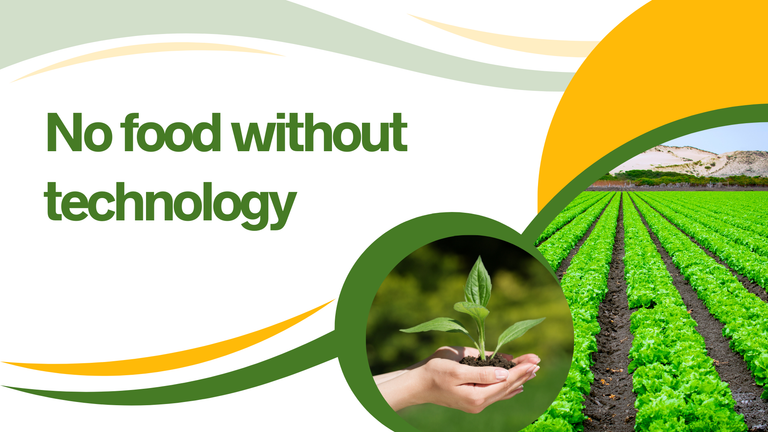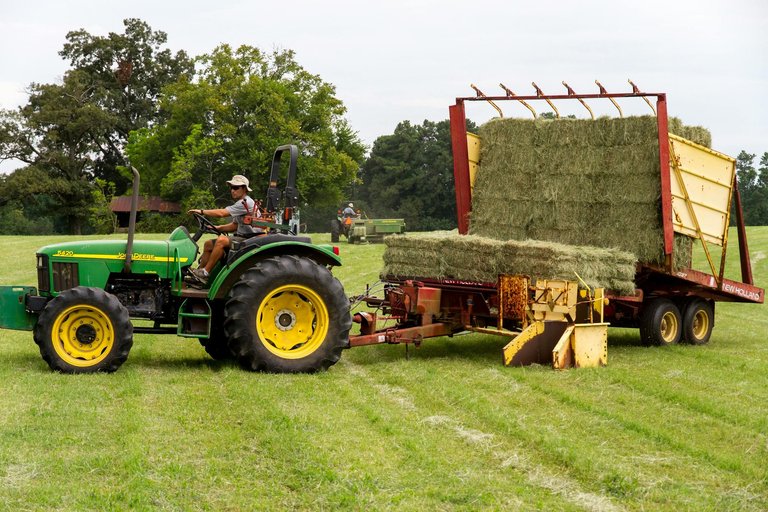[EN/PT] No Food Without Tecnology
[EN]

With the advent of the Industrial Revolution in the 18th century, there were profound changes in labor relations and the production system of the time. The invention of the steam engine was the initial milestone in the mechanization of production processes, especially in industry, consolidating capitalism as the main economic system that still dominates the modern world.
Technological evolution arises largely from the need to increase productivity, with science being primarily responsible for optimizing existing methods and processes, as well as creating new and sophisticated tools. This evolution is present in all sectors of human society and, when comparing the advantages and disadvantages of its use, it is clear that the advantages prevail.
Mechanization and automation in agriculture are good examples of technological progress. In the past, man used animals, such as cattle, to plow the land, a task that used to be carried out manually with a hoe. Over time, heavy machinery began to be used, with man driving it. Today, there are automatic machines, with or without human intervention, which carry out all stages of the agricultural process, from planting to harvesting.
The evolution of technology has made it possible to grow food en masse, which is essential for feeding more than 8 billion people around the world. Imagine how feasible it would be to grow food by hand for a population of that magnitude! There's no denying that large-scale production is only possible thanks to technological advances. However, to ensure the mass production of food, the use of pesticides has become necessary to prevent pests and stimulate plant growth. Over time, the taste of food has been altered, largely due to the creation of transgenic foods, which are more resistant and produce more than natural varieties. This, combined with the high concentrations of pesticides present, raises concerns about the nutritional quality of these foods.

On the one hand, technology is able to meet the growing demands of the world's population. On the other hand, modern food has become a real trap, in which most people consume products full of chemical substances that, in the long term, can cause illness and compromise quality of life, especially in old age.
Processed food is also losing quality. In the past, products used better quality ingredients. I remember how, in my childhood, a box of chocolates was filled with delicious chocolates that were actually made with chocolate. Nowadays, I prefer to avoid these boxes of chocolates, which are full of sugar and whose chocolate, unfortunately, is no longer the main ingredient. What's more, preservatives, dyes and flavorings replace the natural ingredients, detracting from the quality of the final product.
Nowadays, it is increasingly difficult to maintain a 100% healthy diet, as natural foods are contaminated with pesticides and the products available on supermarket shelves are losing quality, especially in an attempt to keep prices affordable in the face of inflation. The only way to escape this reality is to grow our own food and raise animals, seeking a way of living closer to nature and to what is healthiest.
If you've made it this far thank you very much for your time and if this content has been useful in any way, please leave your upvote and reblog!

[PT]

Com o advento da Revolução Industrial, no século XVIII, ocorreram profundas transformações nas relações de trabalho e no sistema de produção da época. A invenção da máquina a vapor foi o marco inicial da mecanização dos processos produtivos, especialmente na indústria, consolidando o capitalismo como o principal sistema econômico que ainda domina o mundo moderno.
A evolução tecnológica surge, em grande parte, da necessidade de aumentar a produtividade, com a ciência sendo a principal responsável por otimizar métodos e processos existentes, além de criar novas e sofisticadas ferramentas. Essa evolução está presente em todos os setores da sociedade humana, e, ao se comparar as vantagens e desvantagens de seu uso, fica claro que as vantagens prevalecem.
A mecanização e automação na agricultura são bons exemplos do avanço tecnológico. No passado, o homem utilizava animais, como o gado, para arar a terra, uma tarefa que antes era executada manualmente com uma enxada. Com o tempo, as máquinas pesadas começaram a ser utilizadas, com o homem dirigindo-as. Atualmente, já existem máquinas automáticas, com ou sem a intervenção humana, que realizam todas as etapas do processo agrícola, desde o plantio até a colheita.
A evolução da tecnologia possibilitou o cultivo em massa de alimentos, essencial para alimentar mais de 8 bilhões de pessoas ao redor do mundo. Imagine como seria viável cultivar alimentos manualmente para uma população dessa magnitude! Não há como negar que a produção em larga escala só é possível graças aos avanços tecnológicos. No entanto, para garantir a produção em massa de alimentos, o uso de agrotóxicos se tornou necessário para evitar pragas e estimular o crescimento das plantas. Com o tempo, o sabor dos alimentos tem sido alterado, em grande parte devido à criação de alimentos transgênicos, que são mais resistentes e produzem mais do que as variedades naturais. Isso, aliado às altas concentrações de agrotóxicos presentes, levanta preocupações sobre a qualidade nutricional desses alimentos.

Por um lado, a tecnologia consegue atender à demanda crescente da população mundial. Por outro, a alimentação moderna se tornou uma verdadeira armadilha, na qual a maioria das pessoas consome produtos cheios de substâncias químicas que, a longo prazo, podem causar doenças e comprometer a qualidade de vida, especialmente na terceira idade.
Além disso, os alimentos processados também têm perdido qualidade. Antigamente, os produtos utilizavam ingredientes de melhor qualidade em sua fabricação. Lembro que, na minha infância, uma caixa de bombons vinha recheada com chocolates deliciosos, feitos de fato com chocolate. Hoje em dia, prefiro evitar essas caixas de bombons, que são repletas de açúcares, e cujo chocolate, infelizmente, já não é mais o principal ingrediente. Além disso, conservantes, corantes e aromatizantes substituem os ingredientes naturais, prejudicando a qualidade do produto final.
Nos dias de hoje, é cada vez mais difícil manter uma alimentação 100% saudável, pois os alimentos naturais estão contaminados com agrotóxicos, e os produtos disponíveis nas prateleiras dos supermercados perdem qualidade, especialmente na tentativa de manter os preços acessíveis diante da inflação. A única maneira de escapar dessa realidade é cultivar nossos próprios alimentos e criar animais, buscando uma forma de viver mais próxima à natureza e ao que há de mais saudável.
Se chegou até aqui muito obrigado pelo seu tempo e se de alguma forma este conteúdo foi útil, deixe seu upvote e reblog!

Posted Using INLEO

Obrigado por promover a comunidade Hive-BR em suas postagens.
Vamos seguir fortalecendo a Hive
Your post was manually curated by @xlety.
Delegate your HP to the hive-br.voter account and earn Hive daily!
🔹 Follow our Curation Trail and don't miss voting! 🔹